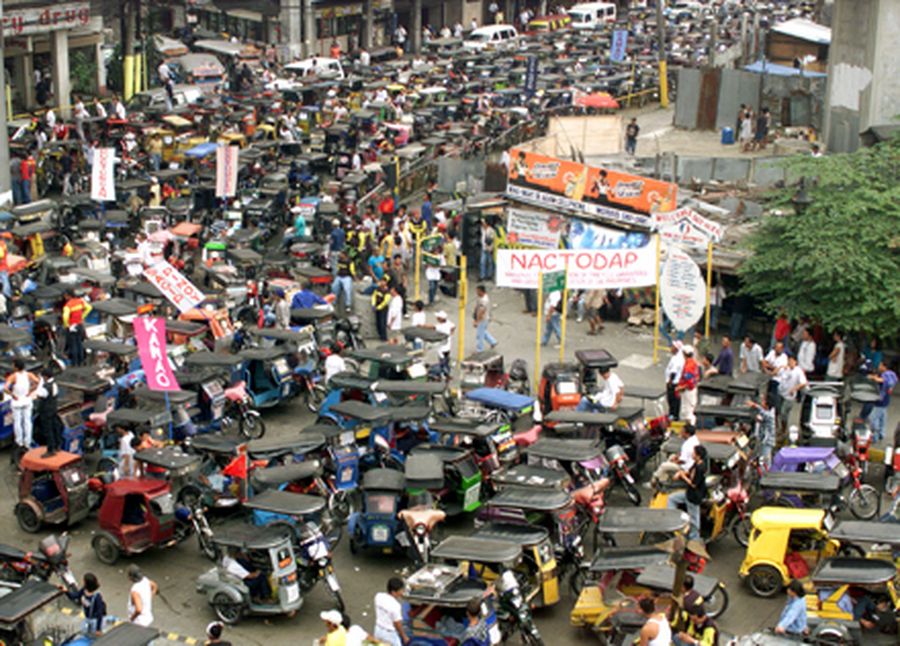The Philippines, host of this year’s ADB Annual Meeting, has slipped behind neighbour Indonesia in the race for an investment-grade credit rating. How can it avoid falling further behind as the rest of the region advances?

Source: Reuters/Alex de la Rosa
Thousands of pedicab drivers paralyse traffic leading to the presidential palace in Manila.
Having worked hard to improve its reputation in the global capital markets, the Philippines was forced to watch with envy late last year as neighbour Indonesia won an upgrades to investment-grade status, first from Fitch and then from Moody’s.
In the bond markets, there is no contest – the Philippines is known as a sophisticated sovereign borrower with a liquid and well-managed credit curve. Even after its neighbour’s upgrade, the Philippines’ cost of insuring its debt against default is consistently 30bp–50bp less than for Indonesia.
Losing out in the rating race, however, is a big blow to the Philippines’ national pride. Even President Benigno Aquino has put his opinion on record, pressuring the rating agencies to bump up the country’s credit score before the end of 2012.
It also hints at a bigger problem for the country. Two decades ago, global investors played the spread between the Philippines and Thailand. The Philippines lost that race, too.
The Philippines is still capable of catching up with its regional peers. To do so, however, it needs to address two major deficiencies – infrastructure spending and governance.
The Philippines consistently spends less than 3% of GDP on infrastructure, versus 5%–7% for most of its regional peers. It pumps only 4% of GDP into education and health, which is fairly low by global standards.
The country ranks No 129 on Transparency International’s Corruption Perceptions Index, trailing regional peers Indonesia, Malaysia, Vietnam and Thailand. The World Bank Institute’s latest Worldwide Governance Indicators put the Philippines in the bottom 25% for control of corruption, reflecting the perception of the extent to which public power is exercised for private gain. Public institutions are weak, and powerful vested interests have, historically, had a big impact on public policy.
“The Philippines has rock-solid macroeconomic fundamentals. Public debt is declining, external debt is low, debt service ratio is low, interest rates are low, and inflation is low and declining. The challenge is to leverage these strengths to generate higher growth, and growth that is more inclusive,” said Neeraj Jain, ADB country director for the Philippines.
Reforms in motion
Having swept to power in 2010, Aquino’s government has a mandate for reform. The president remains popular at home and abroad, giving the administration an opportunity to push through much-needed changes.
Early steps have been encouraging. Institutional reforms are in the works, and eradicating corruption is high on the government’s list of priorities.
After years of delays – not least due to their negative impact on powerful industry leaders – excise tax reforms are poised to pass through congress finally. The IMF and WHO have thrown their support behind the measures. If successful, that single piece of legislation has the potential to reinforce the power of the Philippines’ public sector institutions, markedly improving the international perception of the country’s public governance.
Former president Gloria Macapagal Arroyo has been charged with corruption, continuing a pattern of indictments against the country’s former political leaders. Although Arroyo’s arrest smacks of a political agenda, the new administration’s decision to pursue such a high-profile case also sends a message that nobody is immune to the crackdown on corruption – no matter how powerful.
The government is also committed to the public-private partnership initiative, having promised to put several projects out for tender this year. Results, however, have been slow: many projects were delayed last year as the new government put them under scrutiny, again as part of its anticorruption drive.
“The president has the will of the Philippine people behind him, but mobilising the system to deliver on those intentions is where more effort is needed,” said Jain. “The Philippines’ biggest risk is a lack of implementation.”
The ADB believes the Philippines has the potential to generate much higher growth than last year’s 3.7%. Jain estimates the economy could expand at 7%–8% if proper policies are put in place, thanks to the Philippines’ young population and English education.
“We think single-mindedly addressing infrastructure constraints, weak public spending in education and health, and single-mindedly addressing governance concerns will lift the Philippines to a much higher growth rate,” he said.
The markets seem to be already confident. Debt portfolio inflows have even begun to complicate monetary policy, having dragged the interbank rate below the policy rate. That gap widened in 2011, rendering the central bank’s policy rate virtually ineffective.
Liquidity is high across the country’s capital markets, but there is a big gap between savings and investment. At the national level, the Philippines has a healthy current account surplus, but that money is not being invested in local industry.
It needs to correct these imbalances and channel more funding into the local system.
“If any Philippine Government can do it, it’s this one,” said Stephen Groff, the ADB’s vice president responsible for South-East Asia. “I’ve never seen such an optimistic group of people in government at any point over the last 25 years. They’re saying the right things, and we certainly hope this will translate into the right kind of investment going forward.”
An investment-grade rating will not alter the Philippines’ prospects for growth – it can already access capital at investment-grade prices. However, it would rubber-stamp the government’s reforms and that could be just the confidence boost the country needs.
